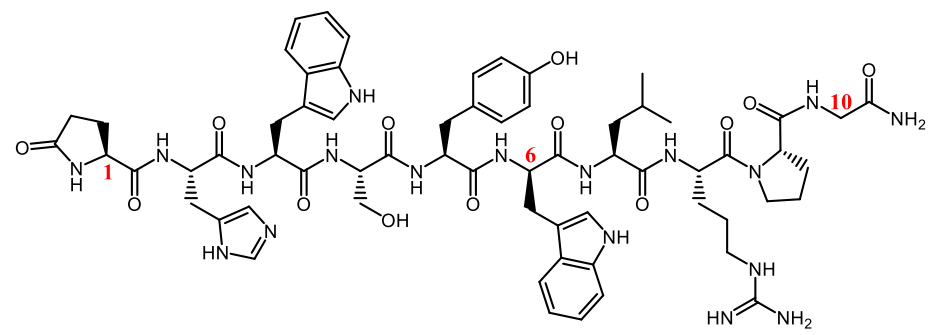Given the rapid metabolism and short action time of peptide drugs, pharmaceutical chemists have explored a variety of methods to improve the metabolic stability of the peptide.
- Replace L-type amino acids with D-type amino acids or unnatural amino acids
The main recognition site of protease in vivo is natural L-type amino acid, so replacing L-type amino acid in the metabolic site with D-type amino acid can weaken the affinity with protease and maintain the physiological activity of the peptide.
Triptorelin is a gonadotropin-releasing hormone (GnRH) analog. It replaces positions 1, 6, and 10 of the natural GnRH with three unnatural amino acid residues. Results suggest that its half-life after intravenous administration is extended to 2.8 hours compared with 5 minutes of the natural GnRH. And it’s mainly cleared by the liver and kidney.

Amino acid residues at both ends of linear peptides are susceptible to degradation by exopeptidases, so modification of terminal residues by methylation or N-acetylation can protect the peptide drugs in the metabolic process.
The glucose-dependent insulinotropic polypeptide (GIP) has a half-life of 2-5 minutes. Mabilleau et al. developed an enzyme-stable GIP analog by acetylating Tyr1 (N-AcGIP) in GIP, with an in vivo half-life greater than 24h.
- Cyclization or double cyclization
The configuration of the linear peptide is unstable, and it’s easy to deform and bind to the catalytic center of protease. The cyclic method can stabilize the peptide configuration, reduce the binding constant (Ka) with protease, and lower the affinity with protease. At the same time, through cyclization, amino acid residues at both ends or metabolic sites can be protected, which becomes an effective way to enhance the stability of peptides. More than two-thirds of the peptide drugs on the market are cyclic peptide compounds. For example:
Many antibiotics of natural origin are cyclic peptides, such as cyclosporine and daptomycin. Cyclosporine is highly stable to gastrointestinal peptidases (>90% intact after 2 hours of incubation). Sandimmune® is a kind of lipid-based preparation, and Neoral® is a microemulsion with improved bioavailability. The final half-life of Neoral® ranges from 5 to 18 hours after oral administration.
Lanreotide, the 8-residue cyclic peptide analog of somatostatin, is used for the treatment of acromegaly (gigantism) and GEP-NETs caused by excessive hormone release by the pituitary gland. Researchers developed subcutaneous long-acting formulations (Somatuline Autogel® and Somatuline Depot®) that can continuously release over a month to avoid daily injections. Lanretide contains two unnatural amino acid residues at sites 1 and 4 and an amidate Thr8. The half-life is extended to 23 to 30 days after modification compared with 3 minutes for endogenous somatostatin.
PEG has a variety of drug-related properties: high water solubility and mobility, low toxicity and immunogenicity, and easy to clear from the body. Similar properties are obtained when the drug is modified with PEG, and the transfer of these properties is positively correlated with the molecular weight of PEG. PEG modification at the end of the peptide chain can not only protect the amino acid residues but also significantly increase the molecular weight and steric hindrance. Lee et al. showed that site-specific pegylation of GLP-1 can result in a 16-times increase in plasma half-life in rats.
Another important purpose of PEG modification with large molecular weight is to reduce glomerular filtration rate and decrease renal clearance. Both mechanisms work together to greatly prolong the elimination half-life in vivo.
- Add ligands to improve binding to albumin or IgG
In vivo, albumin or IgG uses the neonatal Fc receptor (FcRn) circulatory pathway to avoid degradation. When albumin is internalized into cells, it has a strong binding with FcRn at pH 6 in endosomes to protect albumin from lysosome degradation. Then, the combination is released outside the cell to a pH 7.4 environment where it releases albumin. In response to this pathway, fatty chain modification was performed in the peptide structure to bind albumin. Liraglutide and Simeglutide both significantly increased their half-lives by this method. Other research methods include covalent binding of peptide and albumin, recombinant expression, etc.
In addition to the methods above, the half-life of drugs in vivo can also be prolonged by the combination of enzyme inhibitors and the use of liposomes and other sustained-release preparations to protect free peptides.
Summary
Further understanding of the metabolic stability of peptides and early discovery of metabolic mechanisms and sites can help researchers carry out structural modifications to improve drug stability, which is very important for the success of the clinical development of peptides. Currently, many long-acting peptide drugs and slow-release delivery preparations have been successfully marketed. With the development of science and technology, including multifunctional peptides, peptide-coupled drugs, and other new molecular types, peptides will have the opportunity to be used to treat more diseases.
Related Products
| Product Name | Description |
| Triptorelin | Triptorelin is a synthetic gonadotropin-releasing hormone (GnRH) peptide agonist that binds to the GnRH receptor. It inhibits the growth of DU145, LNCaP, and PC3 prostate and OVCAR-3 ovarian cancer cells. |
| Daptomycin | Daptomycin is a cyclic lipopeptide antibiotic that inhibits GRAM-POSITIVE BACTERIA. |
References
1. Yao JF, Yang H, Zhao YZ, Xue M. Metabolism of Peptide Drugs and Strategies to Improve their Metabolic Stability. Curr Drug Metab. 2018;19(11):892-901.
2. Sharma, R.; McDonald, T.S.; Eng, H,; Limberakis, C.; Stevens, B.D.; Patel, S.; Kalgutkar, A.S. In vitro Metabolism of the Glucagon-Like Peptide-1 (GLP-1)-Derived Metabolites GLP-1(9-36)amide and GLP-1(28-36)amide in Mouse and Human Hepatocytes. Drug Metab. Dispos., 2013, 41, 2148-2157.
3. Serada M, Sakurai-Tanikawa A, Igarashi M, Mitsugi K, Takano T, Shibusawa K, Kohira T. The role of the liver and kidneys in the pharmacokinetics of subcutaneously administered teriparatide acetate in rats. Xenobiotica. 2012 Apr;42(4):398-407.
4. A. Zorzi, K. Deyle and C. Heinis, Cyclic peptide therapeutics: past, present and future, Curr. Opin. Chem. Biol., 2017, 38, 24–29.